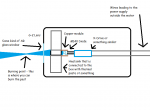If you decide to go the fiber route, to preserve beam quality you would have to use a single-mode (TEM00) laser precisely focused into the end of a (very small!) singlemode fiber at a specific conical angle (I've read that microscope objectives in micrometer mounts are often used for this very exacting purpose), then expand/collimate/focus at the other end of the fiber. Quite the project!
I just thought of something else. IF the laser output is polarized, all you have to do is make sure the beam enters through the tank glass (or still water surface) at Brewster's angle (you might go to Sam's Laser FAQ page, or Wiki it to learn about it). At this one angle, polarized laser light oriented correctly, will pass into the tank with almost no loss at all by reflection. Because of refraction though, the beam will bend as it passes into the tank and you will have to figure out the geometry. That way your laser wouldn't have to take a dunk.
One way to check a laser's polarity is to simply aim it at a glass table top at Brewster's angle. Note the amount reflected off the glass. Rotate the laser slowly while maintaining the angle. If the beam is polarized you will notice as you rotate the laser that the amount of light reflecting off the glass will change. At Brewster's angle, when the polarization is horizontal, most if not all of the laser energy will reflect off the glass; when the polarization is vertical, most if not all of the energy will pass through the glass with very little reflection. A nonpolarized laser beam will not show this characteristic. The polarization orientation can then be marked on the laser for future reference.
The laser might then be mounted on a tripod and adjusted so that the beam satisfies two criteria: 1. Properly oriented/polarized beam enters the water (or tank glass) at Brewster's angle. 2. Beam hits target while satisfying the first condition.
Then you simply use a lens between the laser and the tank to focus, and nothing gets wet/shorted/blown up ;-)
Fyi,
T.




